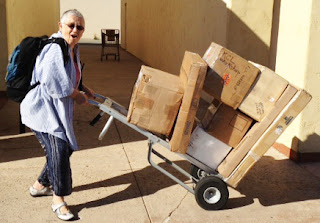The season of darkness is upon
us. Whether you call it midwinter, the longest night, the shortest day, the
first day of winter, or winter solstice, the latter part of December issues an
invitation to slow down after summer's frenzy of activities and fall's exhuberant harvest.
Often we seek to avoid the long dark
days that winter brings - constant days bereft of light, months filled with
colder temperatures, the bleakness of land, the emptiness of trees, and
endless gray skies.
Invitation 1: Ponder darkness as a spur to reverencing the mysteriousness of the universe.
Our ancestors developed a cornucopia of therapies to help with the transition into winter’s dark days: large ongoing fires and lots of lights; decorating homes with holly, ivy, mistletoe, and evergreens; giving of fresh fruit and holding of feasts; time and communion with family, friends, and close ones; as well as dancing and singing.
Our sister mammal, the northern bear, shows us another approach. She sniffs the air, listens to the sounds of silence all around, and with a great yawn descends into the bowels of the earth for a long winter nap. She truly understands that slowing down is part of a larger natural rhythm and goes willingly into the darkness.
Invitation 2: Reflect upon winter’s wisdom - the need for withdrawal as an essential part of renewal.
Cultures all over the world have taken this time of year to recognize the
reality of rebirth. They knew that seeds need darkness in which to germinate and eagerly
anticipated that moment when Earth comes forth from this time of withdrawal into
a season filled with light.
In Vancouver, B.C., some communities create and then walk a Labyrinth of Light. Lighted with more than 700 pure beeswax candle luminarias, the labyrinth invites visitors to warm themselves in a self-guided ceremony intended to release old attachments and envision new possibilities as a new season is birthed. This mimics an older ritual in which communities kept a fire burning until the end of festivities, to burn away the unhappiness of the previous year.
In Vancouver, B.C., some communities create and then walk a Labyrinth of Light. Lighted with more than 700 pure beeswax candle luminarias, the labyrinth invites visitors to warm themselves in a self-guided ceremony intended to release old attachments and envision new possibilities as a new season is birthed. This mimics an older ritual in which communities kept a fire burning until the end of festivities, to burn away the unhappiness of the previous year.
Invitation
3: Design your own walking meditation in which you
- Contemplate the elemental beings of earth, air, fire and water
- Honor the guides, guardians and teachers who have helped you
- Acknowledge the source of life itself
- Welcome the devic and angelic forces constantly present amongst us
- Choose individual angel qualities for support during the coming year
May Winter Solstice 2012 be a
time of reflection, releasing of the past, and opening to renewal.



















































